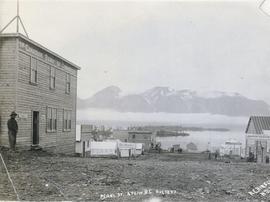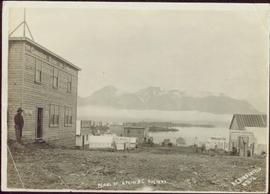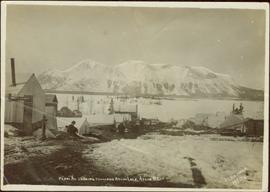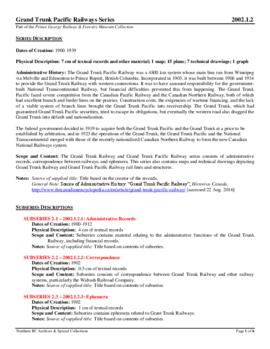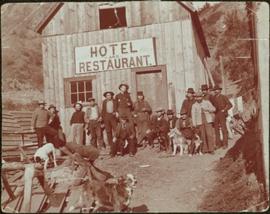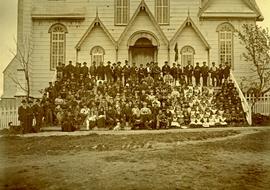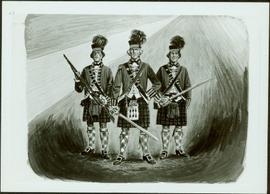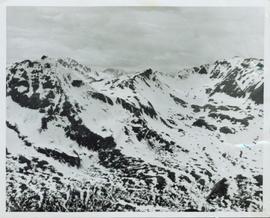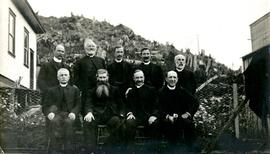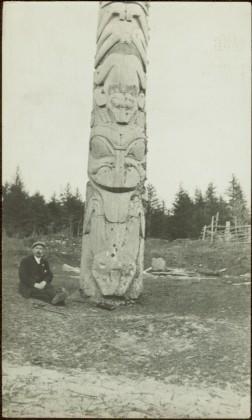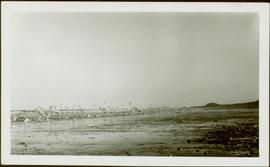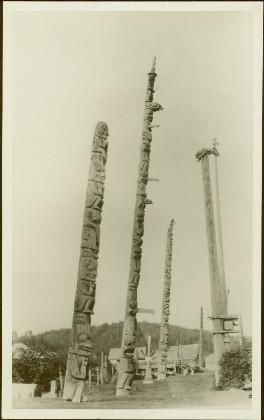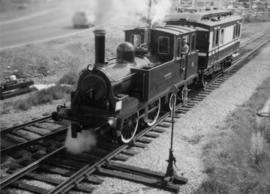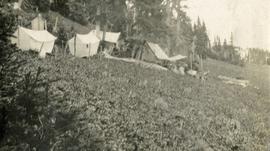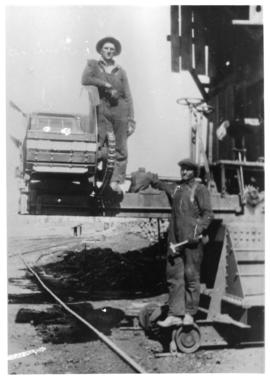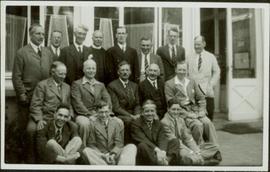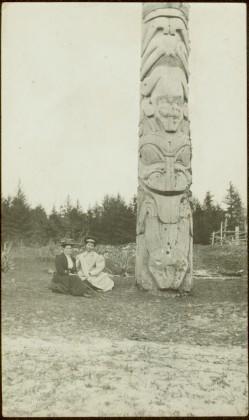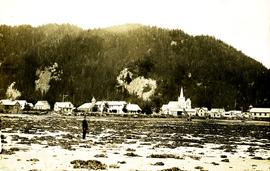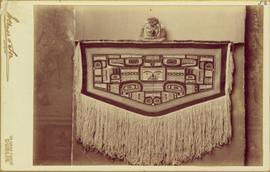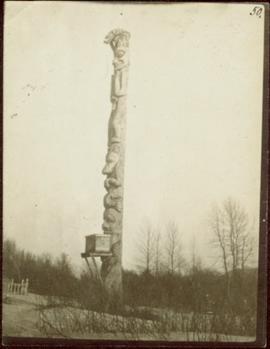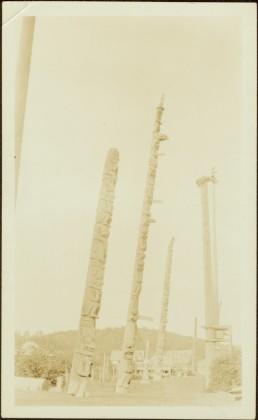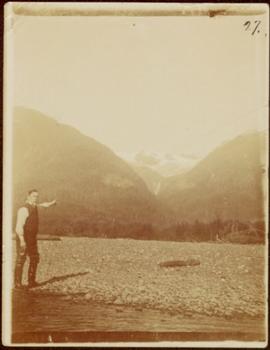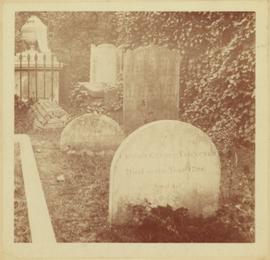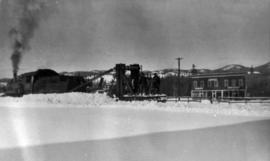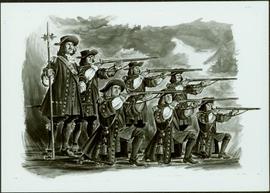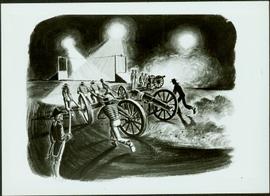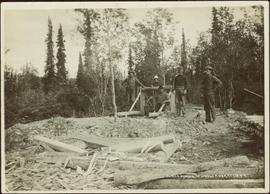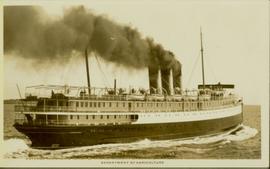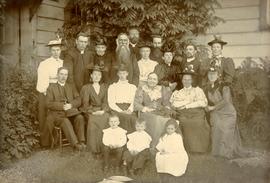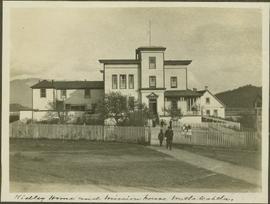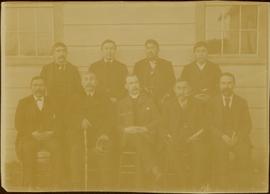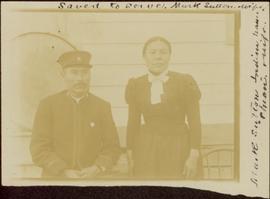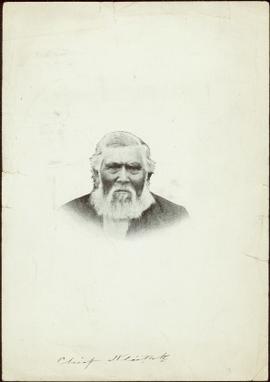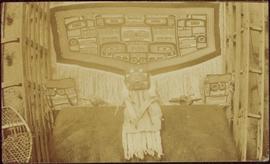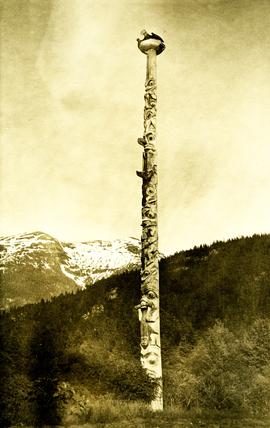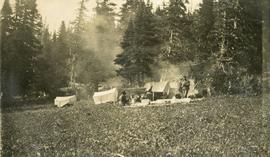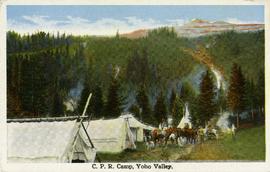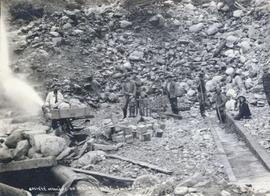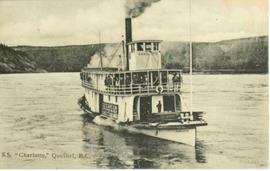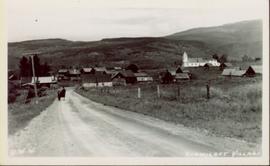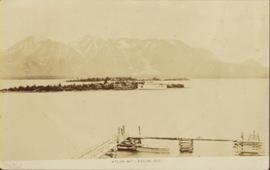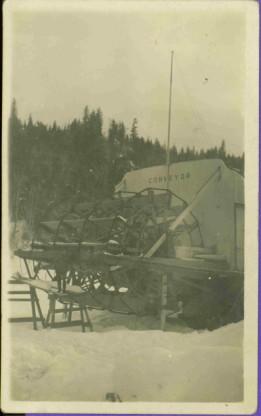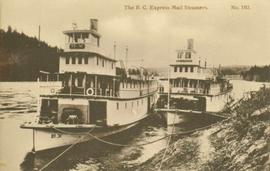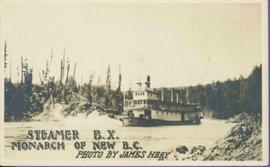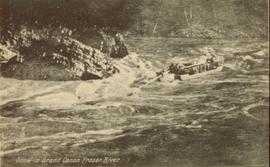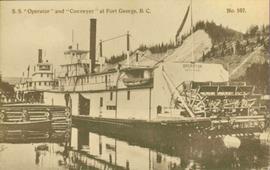Swanton, John Reed. “Materials relating to the Haida.” [1898?]. Manuscript 4117-a, National Anthropological Archives, Smithsonian Institution.
Photograph depicts buildings and signage on either side of dirt road. Unidentified man stands on far left, Atlin Lake and mountains can be seen in background.
Hand inscribed annotation on recto of photograph reads: “Pearl St., Atlin, B.C. Aug. 1899. A.C. Hirschfeld, No.74”.
Photograph depicts tent buildings on either side of dirt road. Unidentified men are visible on left, Atlin Lake and mountains can be seen in background.
Hand inscribed annotation on recto of photograph reads: “Pearl Av. looking towards Atlin Lake, Atlin, B.C., A.C. Hirschfeld, No. 174”
The Grand Trunk Railway and Grand Trunk Pacific Railway series consists of administrative records, correspondence between railways, and ephemera. Also consists of maps and technical drawings depicting Grand Trunk Railway and Grand Trunk Pacific Railway rail lines and structures.
Photograph depicts group of working men and 6 dogs standing outside wood building. Hill in background.
File includes "In the Wake of the War Canoe" Chapter XX revisions and a note from donor Jean Whiffin on behalf of Joyce Collison regarding the revisions.
Large group of women, men, and children pose on front steps of church. Some men standing in back hold brass instruments. Bishop Ridley (with long beard) sits in front centre between W.H. Collison (on right) and his son W.E. Collison. Photograph depicts the first church built in Metlakatla, which was burned in a fire in 1901, and replaced in 1903.
Handwritten annotation below image reads: "A gathering of Missionaries and Indians in front of Metlakahtla Church During Synod"; on verso: "[Ven?] Arch Collison & Mrs Collison".
Village can be seen in distance. Large church building stands in centre, hills in background.
Handwritten annotation on verso reads: "For heading of Page 18. Kincolith or 'The Rock of Scalps.' Section of Kincolith [...]"
Photograph depicts the a painting of three men in the Royal Highland military uniforms. Typed annotation glued to verso of photograph provides an interpretation of this piece of art: "The 42nd (Royal Highland) Regiment of Foot - 1782. The first battalion of this British regiment arrived in New York in 1756. After serving in numerous campaigns and engagements in North America, the 42nd (Royal Highland) Regiment of Foot garrisoned in Nova Scotia. It is from this famous regiment that the Black Watch (Royal Highland) Regiment of Canada derives its name and much of its colorful dress and traditions."; "Le 42nd (Royal Highland) Regiment of Foot - 1782. Le premier bataillon de ce régiment britannique arriva à New-York en 1756. Après plusieurs campagnes en Amérique du Nord, il fit garnison en Nouvelle-Ecosse. C'est de ce fameux régiment que s'inspirent les uniformes et les traditions du Black Watch (Royal Highland) Regiment of Canada. Cornemuses et tambours y ont toujours joué un rôle important et pittoresque."
Overview of a snow covered mountain tops of the Cassiar Mountains. Handwritten annotation on verso in pen reads: “Cassiar mtns.”
Group poses between two buildings, small dog visible behind. Wood piles and tree stumps can be seen on hill in background.
Handwritten annotation on verso reads: "Metlakatla BC / Back row - W.E. Collison, Fr. Hogan, ?, ? Canon Keen / Front row - ?, ?, Bishop Du Vernet, Archdeacon Laycock". See also item 2009.7.1.32 for image featuring Father Hogan, and 2009.7.1.29 for image featuring Bishop Du Vernet.
Rev. W.E. Collison sits to left of totem pole, smoking a pipe (oldest son of Marion and Archdeacon W.H. Collison). Log fence can be seen in front of forest in right background.
Handwritten annotations on verso read: “W.E. Collison at Massett, QCIs."; "Dad beside totem pole".
Photograph depicts a flock of birds at beach, water and shoreline in background.
Handwritten annotation on verso reads: “North Beach Massett QCIs."
The David Davies Railway Collection encompasses all facets of railway history specifically in the province of British Columbia and the Yukon territory. The collection consists of research material accumulated over the course of more than fifty years, and includes monographs, periodicals, articles, clippings, railway timetables, photographs, maps and plans, and excerpts. Material covers public, tourist, and private (industrial) railways, including: CPR, KVR, E&N; CNR, CNoR, GTPR; and PGER, BCR. The collection excludes material regarding streetcar systems and rapid transit, but includes long distance electric interurbans.
Photograph depicts a cluster of canvas tents on the edge of an alpine meadow.
Photograph depicts 2 railroad workers. Annotation on verso of photograph reads, "Carl Wagner (top) leaning on car loader - early 1900's; Mountain Park Alberta".
Group portrait featuring 3 rows of unidentified men in suits and one member of the clergy posed on a sidewalk outside a storefront at Atlin, B.C.
The pair sits on ground beside large totem pole, Bertha on left (wife of W.E. Collison). Log fence can be seen in front of forest in right background.
Handwritten annotation on verso reads: “Mother & Josie Edenshaw at Massett".
Village can be seen in distance. Large church building stands in centre, hills in background.
Handwritten annotation on verso reads: "Grand Dad on beach at Kincolith".
Chief’s ceremonial Chilkat robe hung for portrait; associated headress is attached to wall above it. Woven headress features the inset face of a carved wooden bird.
Handwritten annotation in pen on verso: “Chief’s Dancing Robe surmounted by Dancing Headress for page 8.” Verso also has additional handwritten annotations which have been crossed out. Stamped photographers mark on recto: “Werner & Son; 39 Grafton St. Dublin.”
Photograph depicts a mortuary pole situated against a snowy landscape.
Handwritten annotation on verso reads: “Chapter XVIII, Nom. 1 Chief Gwaksho’s totem pole. The Great Hunter.”
W.H. Collison stands on a rocky river bed pointing to a pass in between distant mountains.
Handwritten annotation in pen on verso reads: “A rift in the mountains for Chapt. XXI. No.4”
Photo featuring Captain Vancouver’s tombstone in the churchyard of St. Peter’s Church in Petersham, England.
Handwritten annotation in pen on verso reads: “Illustration from this to be inserted. No. 4.3. on page 183 of manuscript. Vancouver’s tomb, Petersham, England”.
Photograph depicts a CNR locomotive pushing snow removal equipment #51070 near a building, possibly a railway station.
Photograph depicts a painting of a battle regiment consisting of six men holding rifles and one man looking on. Typed annotation glued to verso of photograph reads: "Le Régiment de Carignan-Salières - 1665. This famous regiment was dispatched to Canada (then called New France) by King Louis XIV and disembarked from its small sailing vessels on eastern shores in the spring of 1665. Historically it was an important event. Until then, the colonists had been obliged to provide their own defence and the French regiment was the first military protection they enjoyed."; "Le Régiment de Carignan-Salières - 1665. Ce fameux régiment fut envoyé au Canada (appelé alors Nouvelle-France) par Louis XIV. Au printemps de 1665, il débarquait sur les rivages de l'est. Jusque-là, les colons avaient dû se défendre par leurs propres moyens; c'était la première protection militaire qui leur était offerte. L'arrivée des troupes régulières ramenèrent l'espoir aux colons découragés."
Photograph depicts a painting of a naval gun race with men in striped shirts pulling canons and an onlooking officer in uniform. Typed annotation glued to verso of photograph provides an interpretation of this piece of art: "Course de canons de la Marine. Deux équipes, en costumes de la Marine de 1812, réalisent une variante sensationnelle de la course de canons traditionnelle de la Marine. Elles doivent démanteler complètement les canons antiques, les porter en une course d'obstacles difficile et les réassembler pour faire feu. Il faut du courage, du muscle, et des mois d'entraînement."; "Naval gun race. Two teams in naval costumes of 1812 stage a thrilling variation on the traditional naval gun race. They must completely dismantle the antique cannons, carry them over a grueling obstacle course and reassemble the guns for firing. It takes courage, muscle and months of training."
Five unidentified miners pose for a photo. Logs and wood scraps in foreground, forest in background.
Printed annotation on recto of photograph: "PLACER MINING, ATLINTOD RIVER, ATLIN, B.C. A.C. HIRSHFELD NO. 753."
Photograph of the SS "Princess Charlotte" on the open ocean. Metallic annotation on recto reads: "C.P.R.SS Princess Charlotte entered according to act of the parliament of Canada, in the year 1908[?]. by A. Shaw, at the Department of Agriculture." Printed annotation on verso reads "Shaw & Co., Photo. Victoria. B.C. (Empire Series)"
Group of men, women, and children pose in front of large building.
Handwritten annotation on verso reads: "Metlakatla BC / with Bishop Ridley - 4th from left - back row / Mrs Ridley - 4th from left - front row / [?] - [super?] of Ridley Home (beside the Bishop) / Father Hogan - behind the Bishop".
Photograph depicts an unidentified man walking on path in front of Bishop Ridley's home. Several children can be seen in fenced yard in midground.
Handwritten annotation below image reads: "Ridley Home and Mission house Metlakahtla."; on verso: "Chapter XXVII / Heading for Chapter / Ridley Home Metlakahtla".
Group of eight men wearing suits and ties pose with Reverend Collison (oldest son of Marion & Archdeacon W.H. Collison).
Handwritten annotation on verso reads: “Rev. W. E. Collison & his Lay Readers at Massett, Q.C.Is.”
Chief Allen sits in chair on raised wooden platform, with bear skin over his knee, and two more bear skins laid on wood blocks in front of him. House stands behind picket fence in background. Pot and pan sit to right of chair in foreground.
Handwritten annotation on verso reads: "Albert Allen Kincolith (Nisga Chief)".
Mark Sutton, in Christian Army uniform, is seated while his wife stands next to him. A drum is visible in the background.
Handwritten annotation in pen on recto reads: “Saved to serve. Mark Sutton & wife. Mark Sutton Indian name ‘Chean’ (?) & wife.” Handwritten annotation in pen on verso reads: “Chapter VI. No. 1. Mark Sutton & wife. Only survivor of crew of canoe shot by war party. Twice doomed but “Saved to Serve.”
Photograph features a portrait of an elder taken from the neck up. Handwritten annotation on recto, along bottom of photo reads: “Chief Stlaituk”(?)
Photograph features an arranged collection of Chief’s ceremonial regalia: Chikat robe and Amalayt (headdress), two carved wooden rattles and two leggings.
Handwritten annotation in pen on recto reads: “Qush ahlied (?) or Chilcat [sic] Robe worn by Chiefs when entertaining. Also 'Ahm Ahlied'(?) or Head Ornament Indian Coronet and leggings." Verso also has additional handwritten annotations which have been crossed out.
Totem pole stands alone against a mountainous background.
Photograph depicts a cluster of tents on the edge of a meadow. Four or more people stand or sit amongst the tents. Smoke rises from a wood fire and drifts amongst the stub alpine trees in the background.
Postcard taken along the CPR line, at a camp in Yoho Valley.
Stern wheeler in river. Printed annotation on recto reads: “S.S. “Charlotte,” Quesnel. B.C.” Handwritten message on verso is addressed to “Mr. O. Winter 1016 V Park St. Victoria B.C.” The dates on the canceled 1 cent Canadian stamp on verso are not readable.
Photograph of the dirt road leading to Hagwilget Village. Residential buildings and a church are visible in the background. Printed annotation on recto reads: "W.W.W. Hagwilget Village."
Photograph of a vessel in a large body of water with several mountains visible in the background. Printed annotation on recto reads: "Atlin Mt., Atlin, B.C."
Stern wheeler “Conveyor” on land, snow on ground, treed hills in background. Handwritten annotation on verso in pencil reads: “Tete Jaune B.C.”
2 Stern wheelers tied to the river bank. Printed annotation on recto reads: “The B.C. Express mail Steamers No. 102.”
Stern wheeler in river. Printed annotation on recto reads: “Steamer B.X. Monarch of New B.C. Photo by James Heay”
Photograph of a scow traveling down the tumultuous Fraser River. Printed annotation on recto reads: "Scow in Grand Canon Fraser River."
Stern wheelers “Operator” and “Conveyor” in dock. Printed annotation on recto reads: “S.S. “Operator” and “Conveyer” at Fort George, B.C. No. 107.”
